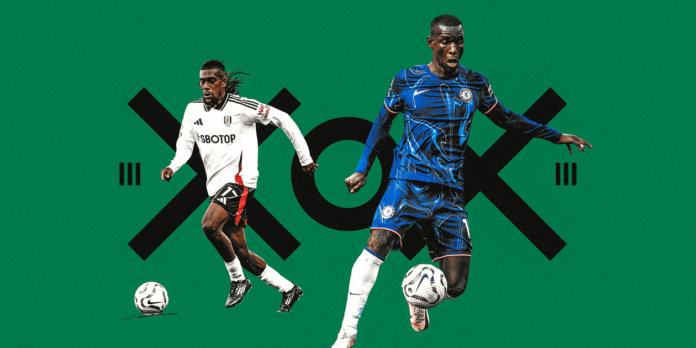It is unwise to draw firm conclusions about your Premier League team in the early weeks of the season.
While it might be premature to spot any statistical trends, that doesn’t stop us from identifying some fun quirks that have stood out. As luck would have it, each of the five teams in question finished outside the top five positions in the Premier League last season. Don’t you love the symmetry?
From West Ham United’s woes to Fulham’s flanks and a word from the xG gods, let’s dive in: feast your eyes on five tactical takeaways from the first five weekends.
Arise, the kick-off kings
Brentford are known for innovation. The club is built on finding value where no one else can, and their latest unveiling has been their front-foot approach to kick-offs.
Thomas Frank’s side started at a blistering pace in their last two games, with strikes from Yoane Wissa and Bryan Mbeumo against Manchester City and Tottenham Hotspur the fastest back-to-back opening goals in Premier League history.
⚡ Lightning starts
The fastest back-to-back opening goals in @premierleague history 🐝 pic.twitter.com/2bzYV0eOPi
— Brentford FC (@BrentfordFC) September 23, 2024
Brentford are the poster boys for set-piece creativity and Frank’s team have clear patterns in their sequences — from throw-in mastery to corner routines that would not be out of place in an NFL playbook. Now they can add kick-offs to that list.
This is shown below across those two games, where a near-identical pattern sees Mikkel Damsgaard pass to goalkeeper Mark Flekken, who plays a diagonal pass to Kristoffer Ajer to win first contact.
Against both sides, this led to a scruffy battle for the second ball — hence the breaking of the sequence — but there is method in Brentford’s approach as they build from there.
“Of course, we work on kick-offs,” Frank said in the press conference after the Spurs game. “Some of it is the ball forward but it is also what we do on the second balls, where we position ourselves, and what we do after that.
“Every set piece we see as an opportunity, so it was well worked by the team and the coaches. It’s one of the more difficult to score from but we see it as a set-play situation we can set up and control as much as possible.”
Surely, they couldn’t make it a third in a row against West Ham on Saturday? Keep an eye out from the first whistle.

Mbeumo celebrates his early goal against Spurs (Marc Atkins/Getty Images)
Jackson benefitting from statistical variance
Last season, Nicolas Jackson’s output could have been filed in a similar category to Liverpool’s Darwin Nunez. Strong physical attributes but finishing needed refinement.
Fourteen league goals in Jackson’s first Premier League campaign was respectable. Only Erling Haaland logged a higher non-penalty expected goals (xG) figure in the Premier League than his 18.6. Unfortunately, that xG underperformance was used as a stick with which to beat him. Only Brennan Johnson of Tottenham Hotspur and Everton’s Dominic Calvert-Lewin underperformed their xG more than he did, scoring nearly five goals fewer than his chances warranted.
Statistical variance suggests Jackson’s underperformance would soon return to typical levels — and that is exactly what has happened this season with four goals in his opening five games. Where last season’s one-v-one chances were previously being saved…
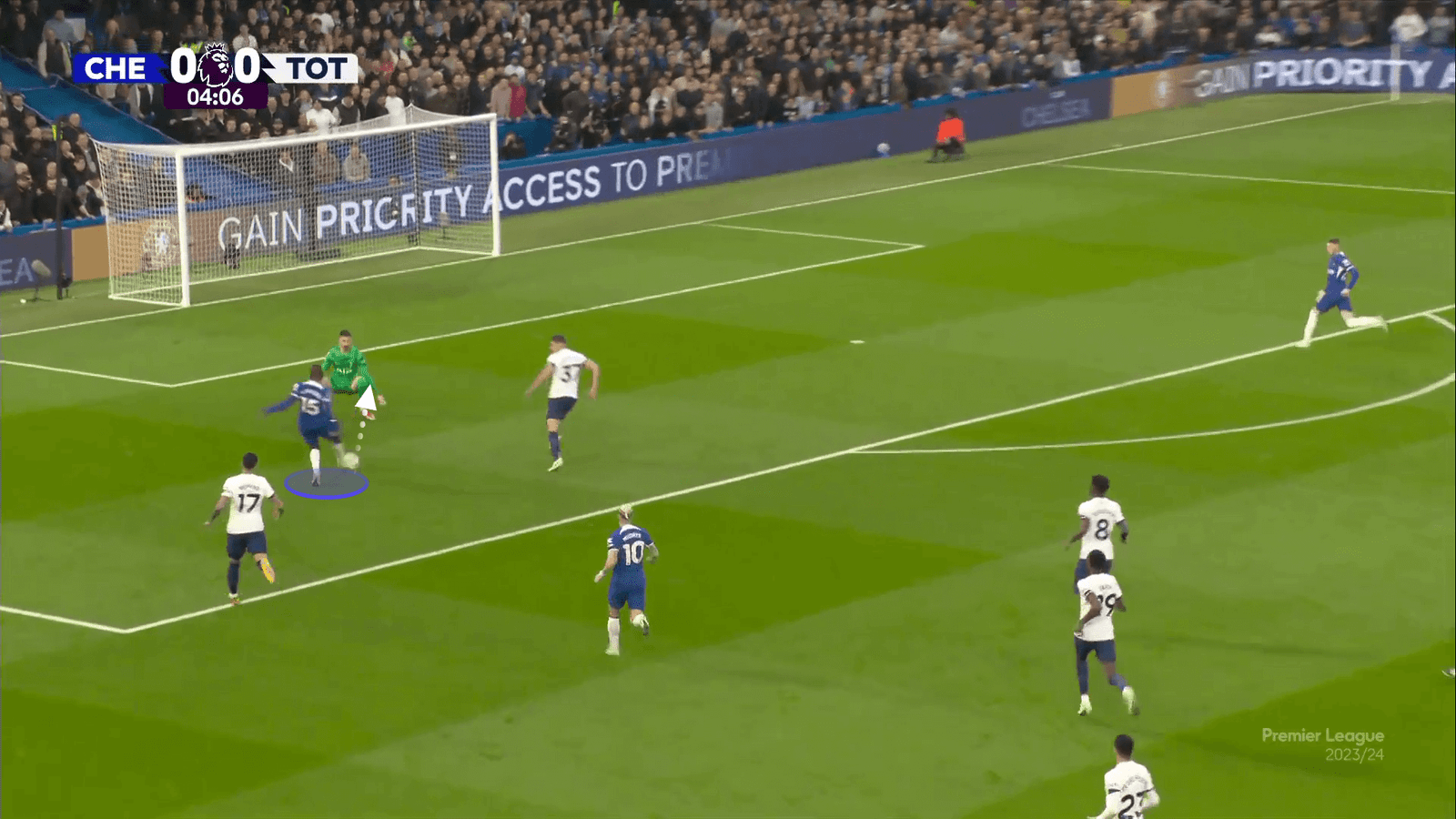
…this season’s Jackson is now emphatically slotting similar efforts with little issue.

Aggregating his shots across his Chelsea career, Jackson’s scoring rate is creeping closer to the quality of chances he has found himself with. Crucially, a 0.24 xG per shot — which measures the average quality of a given chance — is the highest among all players with 50-plus shots since Jackson arrived in the Premier League.
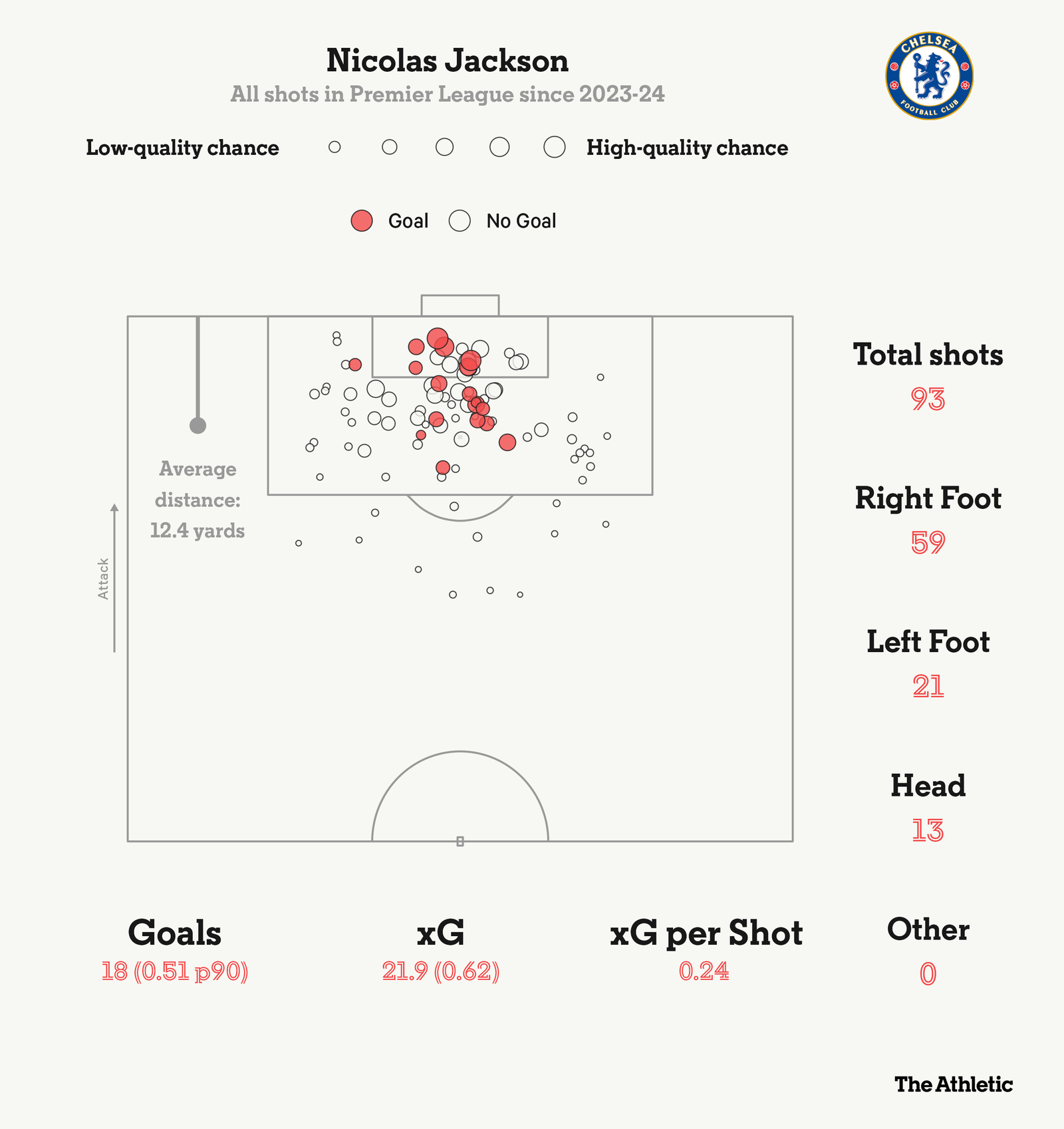
Those are the sort of numbers that make for a sustainable source of goals. The process has always been good, now Jackson’s output looks to be catching up at the same rate.
Forest’s attacking patterns
Nottingham Forest’s unbeaten start in their opening five games was not on anyone’s bingo card, but Nuno Espirito Santo has established a clear way of playing built on the foundations laid by Steve Cooper.
In particular, the pace of Anthony Elanga, Callum Hudson-Odoi, and Morgan Gibbs-White provide a strong counter-attacking threat when Forest burst forward, with the trio able to drag their team upfield at speed when Forest regain possession in their own third.
It makes sense to utilise the strengths of such strong ball-carriers, but Forest’s sharp, one-touch passing has also caught the eye — enabling them to pierce opposition defences with neat “up-back-and-through” principles.
The pattern is simple but effective. The ball is played “up” to a forward who drops it “back” to a team-mate to play it “through” to a runner ahead of the ball. This can be seen in the sequence for Forest’s opening goal against Bournemouth…

…. and was on show again last weekend against Brighton. Note Chris Wood’s run towards the ball drags Brighton centre-back Jan Paul van Hecke out of position, allowing Gibbs-White to play the ball through to Jota Silva.
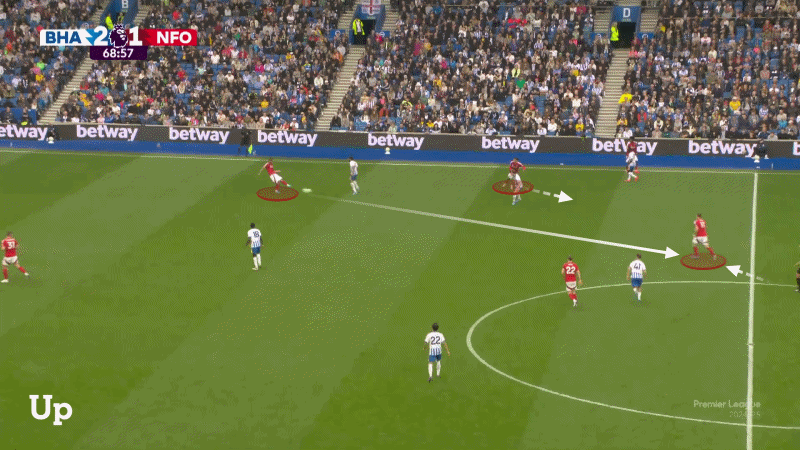
Good summer business and a full pre-season has helped Nuno instil his ideas in and out of possession, as Forest look to cement themselves as a Premier League side.
West Ham have lost their counter-attacking threat
In contrast to Forest’s approach, West Ham United’s new era under Julen Lopetegui has seen them stray from the counter-attacking style that was their biggest strength.
Fans often wrestled with David Moyes’ pragmatic-yet-effective counter-attacking football that would see their side stay compact for long stretches before springing forward with pace.
Last season, only Liverpool, Arsenal, and Aston Villa scored more than West Ham’s 12 goals from direct attacks — possessions starting in the defensive half and leading to a shot or touch inside the opposition penalty area within 15 seconds — as Moyes’ side packed a punch in those transitional moments.
However, that approach has all but disappeared. West Ham have attempted just eight direct attacks this season — the fewest in the league — as they search for an identity under Lopetegui.
Tough opening fixtures have complicated the transition towards a new style, but playing against Chelsea, Manchester City and Aston Villa should provide even more reason to keep a resolute, deeper block and exploit spaces when possible. Against elite sides, playing a high line with little pressure on the ball is nothing short of tactical suicide — as West Ham have found out in recent weeks.

It is the first time in their history West Ham have suffered three consecutive home defeats at the start of a league season.
Patience is required as the quality in the squad will undoubtedly shine through, but some of the early-season performances have highlighted that there is plenty of work to be done in transforming West Ham’s style, both in and out of possession.
Fulham wide connections are strong
Fulham’s opening goal against Newcastle would not have been an unfamiliar sighting at Molineux circa 2019, as former Wolves pair Adama Traore and Raul Jimenez linked up for a well-worked crossing sequence.
Crossing has been a cornerstone of Fulham’s play under Marco Silva, with only Luton Town averaging more open-play crosses than Fulham’s 14.1 per 90 minutes last season.
Silva’s wide play has taken on a new form with Traore building a strong relationship with full-back Kenny Tete and midfielder Andreas Pereira on Fulham’s right flank. Having started only one Premier League game in 2023-24, Traore is building momentum and reminding fans of his quality with consistent minutes after an injury-played campaign.
Those micro-networks have been crucial for Fulham, as shown in their pass connection matrix below. Calvin Bassey playing it to Bernd Leno and Antonee Robinson, and Leno finding Bassey as an immediate option in front of him, stand out (highlighted in red shade). But the frequency of passes between Pereira, Traore and Tete is also clear to see.

The same goes for Fulham’s left wing, where the attacking threat of Robinson and Alex Iwobi has been supercharged by the arrival of Emile Smith Rowe. Two goals and an assist is a great start from the former Arsenal man, and the link-up between the left-side trio was on show again against Newcastle.
With Smith Rowe operating in the left half-space, Iwobi will often drift inside which enables Robinson to overlap (slide two below) and stretch the opposition back line. It was a perfect example of the combination in action as Smith Rowe ran onto Iwobi’s pass to stab home.
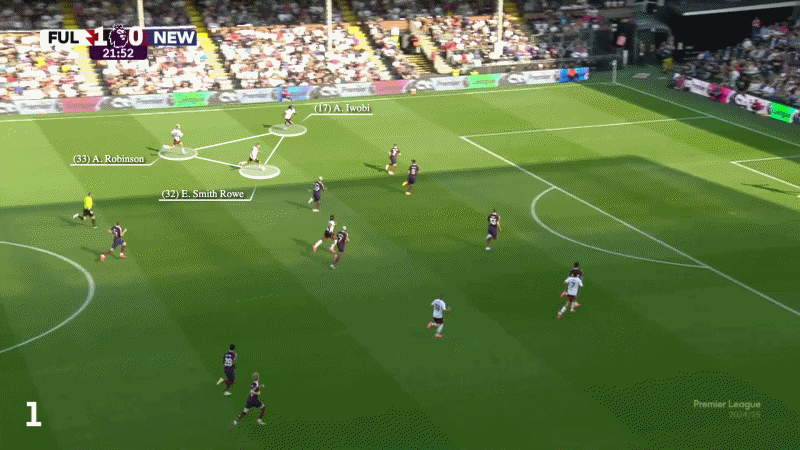
It is a pattern spotted by The Athletic earlier this season, this time with Robinson’s run being found by Iwobi who crosses deep to the back post. The man on the end of it? The in-form Traore.

If Fulham are to build on their 13th-placed finish last year, a lot of their success will be down to those networks and relationships forming on both flanks.
(Top photos: Getty Images; Adam Davy/PA Images, Visionhaus)
Read the full article here


